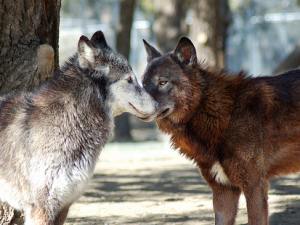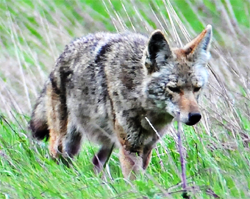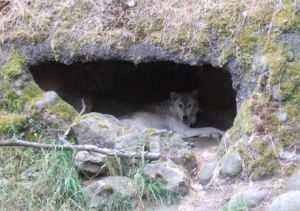Mature threads (and thus, threads involving sex) are allowed at ‘Souls, provided one adheres strictly to the Mature Content procedures.
For puppies to be born and survive, the parents (and their respective roleplayers) must follow the guidelines on the Procedures page.
Reproductive Age
At ‘Souls, all Luperci, regardless of species, are officially sexually mature (able to reproduce) at 1.5 years (eighteen months). If the individual so desires, sexual activity may start before this time, but no pregnancy can occur before they are eighteen months of age. Note that this is more lenient than reality, where wolves are usually sexually mature at two years.
Despite longer lifespans compared to their ancestors, a Luperci’s prime breeding years are similar: from two to around six years of age. Males as old as 12 years may still be fertile and produce viable sperm, but sperm counts would be much lower, leading to fewer productive couplings.
For females, fertility decreases considerably after six years of age, and carrying a litter to term becomes increasingly risky for both the mother and her litter. How many previous litters a female has had also factors into the viability of future pregnancies, and in general, pregnancies after the fourth are discouraged. Older females are also less able to carry large litters.
For simplicity’s sake, our hard cut-off for reproductive viability is 12 years for males and 10 years for females of all species.
However, individuals of both sexes older than 6 years of age should keep in mind the increased difficulty of conceiving and carrying a litter to term. Older females should endure a realistic degree of difficulty in their pregnancy and/or appropriate consequences to their health or in the health of the litter, including but not limited to:
- Increased pain and discomfort during pregnancy (full body aches, abdominal cramps, extreme hormonal shifts, etc)
- Increased and more extreme bouts of weakness, fatigue, change in appetite, muscle aches
- Increased mood swings, irritability, insomnia
- Increased risk of miscarriage, stillborns, and premature births (high risk of death; canine gestations are short!)
- Increased risk of birth defects and abnormalities
- Increased risk of blood loss and injury during birth
Hybridization
Wolves, coyotes, jackals, dogs, and all other Luperci-capable species—that is, within the genus Canis—are able to interbreed and produce fertile offspring. These types of hybrids have been proven possible through human experimentation or accidental hybridization in the wild.

Estrous Cycles
‘Souls does not mandate that any details of reproduction ever be roleplayed, and thus allows a fair amount of leniency regarding many such details, including female cycles.
There is no designated breeding season, and players are free to adhere to whatever system makes the most sense to them, whether canine-based or human-based, or to not think about cycles at all.
Your character can have a more human cycle, including more frequent cycles of fertility and menses, or your character can have a more canine cycle, including annual or bi-annual cycles of fertility and periods of heat. Or you can blend both and have a canine cycle without the heat, or a human cycle with monthly heat. As long as what you’re doing has a basis in some reality, we’re typically okay with it!
Mating
Mating may occur at ‘Souls at any time. For a sexual encounter to give way to puppies, the female must be ovulating at the time. Otherwise, it is purely for pleasure and will not result in puppies. Estrous cycles (regardless of how individual players decide to play them) are very easy to track and accidental parenthood should be rare, but we all know how well that goes with humans, so…
When normal canines mate, or when Luperci mate in their Lupus forms, the male mounts the female, they do their thing, and then they get locked together for about an hour to ensure parenthood. The female is incapable of mating twenty-four hours afterward. When Luperci mate in Optime form, things are basically the same, except they’re afforded the usual human leniency as far as position and kinkiness goes.
Roleplaying sexual encounters is, of course, entirely optional. “Fading to black” (ending the thread and assuming the encounter happened) is perfectly acceptable.
Gestation
The gestational period of a wolf is around 60-63 days. During this period of time, the female will seek a den and ready it for the upcoming birth. Traditionally, a den should be near water so the mother may get water whenever she wishes and not have to go for a long run. The den should be in a prey-abundant area and can either be dug by hand or created from an old cave.
Dens in riverbanks are not uncommon because of the softness of the soil and the proximity to water, but it is dangerous to select a den so close to flooding zone in spring, when the ice and spring rains cause the rivers to flow. A den may also just be a big hole dug into the ground — it’s up to the mother and her mate, really. Near tree roots is prime territory: the soil is soft and the tree provides some shelter. It is also possible for mothers to den in a house or other structure.

The birth occurs on or around the 63rd day of gestation. The mother crawls into her den and lies down to give birth. Her puppies weigh around one pound at birth, and as soon as they enter the world, the mother cleans them up and severs the umbilical cord. The mother eats the puppies’ placenta, umbilical cords, and amniotic sacs following birth, and directs them toward her nipples. If the mother is a Luperci, regardless of whether she carried them in a different form, her puppies are born in their Lupus forms.
Luperci Gestation
A Luperci mother’s gestation is almost exactly the same as a regular wolf’s gestation; however, shifting becomes dangerous for the mother and her litter as the pregnancy advances. An approximation (not hard guideline) of the likelihood of danger:
- Week 1-2: Completely safe
- Week 3-4: Relatively safe, but should be avoided where possible — it’s unlikely (but not impossible) shifting would kill the mother, but it becomes more likely to endanger the puppies
- Week 5-6: Likely to harm or kill children, and medium risk of maternal death — reproductive damage may occur in some cases
- Week 7: Deadly to children and high risk of maternal death — where maternal death does not occur, reproductive damage is certain
- Week 8-9: Deadly to both mother and child

Puppies
Puppies are born blind, deaf, and basically helpless — almost immediately, however, they begin growing and adapting to their environment. Luperci puppies are always born in Lupus form, regardless of their mother’s preferred form. By six months old, puppies are almost indistinguishable from adults; this is also around when most Luperci children begin shifting. By twelve months, they are fully grown.
For detailed information regarding the growth of puppies (including language acquisition, psychology, and basic growth changes), please see the Puppies section.